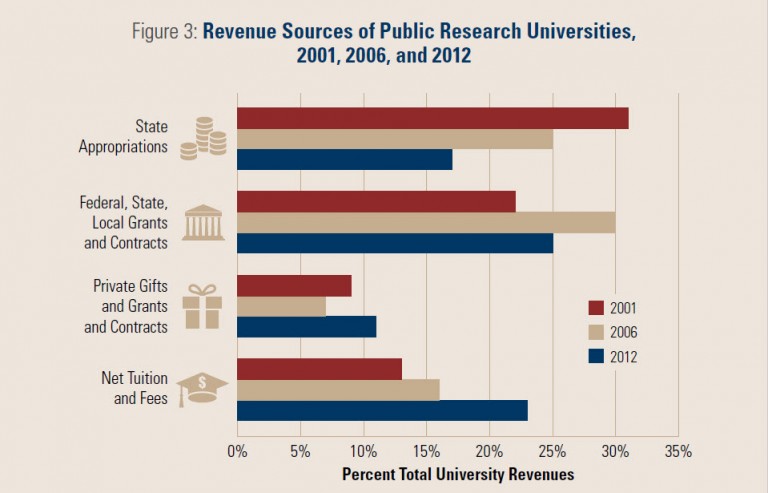Innovation, meet frustration.
I’ve written frequently about how the lack of a reward system hampers (if not quashes) attempts to improve teaching and learning, especially at research universities. A new survey only reinforces that short-sighted approach.
The survey was conducted by the consulting and research firm Ithaka S+R and involved a random sample of faculty members at U.S. universities in 2015. Ithaka has conducted the survey every three years since 2000.
The survey did offer reason for optimism: More than 60 percent of faculty members said they would like to use digital technology and new pedagogies to improve their teaching. The problem: Only 35 percent said their universities recognized or rewarded faculty for innovations in teaching.
The upshot: Most courses at most universities will remain mired in the past, failing to move beyond a curricular approach that emphasizes delivery and regurgitation of information over critical thinking, application, and adaptability. Only a small number of faculty members will be willing to risk the challenge of pedagogical innovation.
That’s especially unfortunate given another of the survey’s findings: More than 60 percent of faculty members in the humanities say that undergraduates do a poor job of finding and evaluating scholarly information. Those in the social sciences, sciences and medical fields are slightly more positive, but overall 54 percent of faculty members find students’ research skills lacking.
The United States has a larger number of colleges and universities relative to overall population than any other country. That provides more opportunities for more students, but it has also made it difficult for universities to distinguish themselves from one another. Research universities, especially, could do that by elevating the importance of teaching. Not only could students learn from top researchers and professionals, but they could learn in creative and innovative ways that would benefit them in the long run.
Or they could continue along the current path where teaching is treated as an afterthought, where one university pretty much looks like all universities, and where pedagogical innovation continually meets frustration.
Other findings from the survey:
- Nearly 40 percent of faculty said open access materials were important to their teaching, but 25 percent said those types of resources were hard to find.
- The percentage of faculty members looking to libraries to help undergraduates improve their research skills grew by 15 to 20 points between 2012 and 2015. The jump was largest among scientists.
- The percentage of faculty who start their research at a physical library has dropped to nearly zero, though humanists are more likely than other disciplines to start at a library. Most start with either a general search engine or a specific database. A slightly smaller percentage start with a library catalog.
Financial challenges and hard questions
Recent statistics cast stark relief on the financial challenges that public colleges and universities face.
Between 1991 and 2008, enrollment at public colleges and universities grew 23 percent, although state support for those institutions rose only 13 percent. By 2010, enrollment rose an additional 8 percent while state support fell by 7 percent.

The statistics come from an analysis of federal data by Steven Brint and Charles Clotfelter. Their article “U.S. Higher Education Effectiveness” was published this month in the Russell Sage Foundation Journal of the Social Sciences.
That declining state support has led to a growing reliance on part-time instructors. Non-tenure-track faculty now make up 37 percent of college and university faculty, up from 19 percent in 1970. Just as disturbing, the growth in spending on instruction has lagged that on student services and research. Actually, “lagged” isn’t quite the right word. Colleges and universities devoted two and a half times as much additional money to research (2.6 percent growth) as they did to teaching (1.1 percent), and nearly twice as much (2.2 percent) to student services.
That’s not bad on its own, but it is symbolic of how far too many universities view teaching. (See above.)
Another study, from an initiative of the American Academy of Arts and Sciences, says that public flagship universities must adopt new financial models given the declining support from states. It called for states to increase their financing of public universities but said universities must reduce costs, seek out additional forms of revenue, and form new public-private partnerships.
In reviewing the state of public higher education, it asks some hard questions: “Is public higher education truly open to the public? Can high school graduates afford to attend their state’s postsecondary institutions?”
Those are pertinent questions given that the number of Americans with high-quality postsecondary credentials lags the needs of a digital-age economy.
One last question from the American Academy study should burn in the minds of all of us in academia: If students can afford to attend college, “what kind of education can they expect to receive?”
The future of higher education depends on how we answer that.
Briefly …
Faculty Focus offers a useful list of ways to deepen student learning. … A study of Chicago high schools found that students did considerably better in face-to-face courses than in similar courses online, NPR reports. … Schools that increasingly rely on digital resources also open themselves to risks of data breaches, PBS reports.
Doug Ward is the associate director of the Center for Teaching Excellence and an associate professor of journalism. You can follow him on Twitter @kuediting.
Tagged future of higher education, learner-centered teaching, state funding, student success, faculty attitudes, innovation, polls and surveys